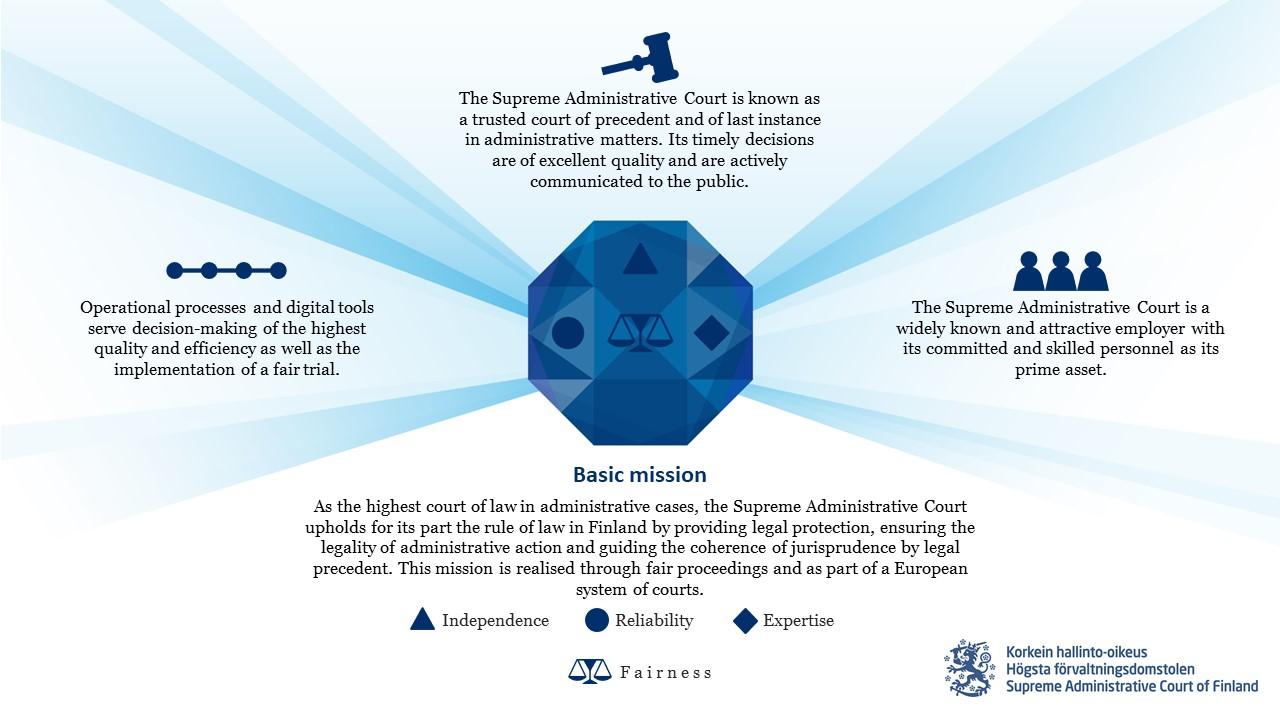Strategy
The strategy formulation process of the Supreme Administrative Court has included an assessment of future changes in the operational environment of the Court. The aim of the process has been to affirm the values guiding the functions of the Court and its basic mission. Based on these, the central aims for the strategy period as well as supporting objectives for the development of the Court’s functions have been defined. Rather than extending to individual judicial decisions, the strategy steers the Court’s operations on a more general level.

Values guiding the functions of the Court
- Fairness within the Supreme Administrative Court is built upon three central values guiding the proceedings, decision-making and internal interactions.
- Independence is the fundamental prerequisite for the work of the Court and a guarantee for its autonomy and impartiality. The Court’s actions are firmly guided by the rule of law and the principle of objective assessment of matters.
- Reliability stems from consistent, balanced and responsible actions, through which the personnel endeavour together to ensure that the parties to proceedings can rely on the lawfulness of decisions.
- Expertise is based on the professional skills and knowledge of a personnel committed to their work and determined to maintain and develop their abilities.
Basic mission
As the highest court of law in administrative cases, the Supreme Administrative Court upholds for its part the rule of law in Finland by providing legal protection, ensuring the legality of administrative action and guiding the coherence of jurisprudence by legal precedent. This mission is realised through fair proceedings and as part of a European system of courts.
Basic aims and strategic objectives
Societal impact
The Supreme Administrative Court is known as a trusted court of precedent and of last instance in administrative matters. Its timely decisions are of excellent quality and are actively communicated to the public.
Objectives
- Decisions of the SAC are expertly and intelligibly written and clearly structured.
- Communication concerning the decisions of the SAC and the decision-making process builds awareness, understanding and trust in the Court’s work.
- Comprehension of the work of the SAC can be promoted by illuminating the role of the court and the boundaries thereof in the reasoning of decisions and in general communications.
Functional processes
Operational processes and digital tools serve decision-making of the highest quality and efficiency as well as the implementation of a fair trial.
Objectives
- Efficient application of the system of leave to appeal reduces the amount of time the cases are pending and improves the quality of precedents.
- Working methods, areas of responsibility and descriptions of duties are suited for the digital working environment.
- Active organisation of judicial proceedings by the Court furthers the realisation of a fair trial.
Personnel
The Supreme Administrative Court is a widely known and attractive employer with its committed and skilled personnel as its prime asset.
Objectives
- The competences of the personnel are maintained and improved and the availability of skilled personnel secured through systematic planning.
- Good leadership and appreciative relations between members of personnel contribute to well-being in the workplace.
- Proficient, responsible and self-directed work is enabled by a functional division of assignments which also ensures that the skills of each employee can be utilised in the most effective way possible.
Attachments
Published 19.10.2021
